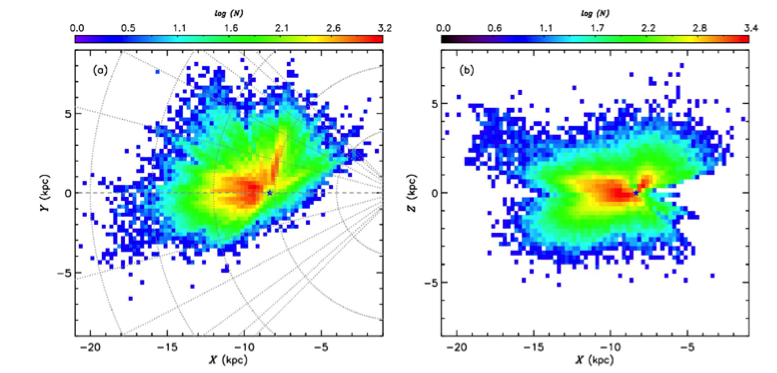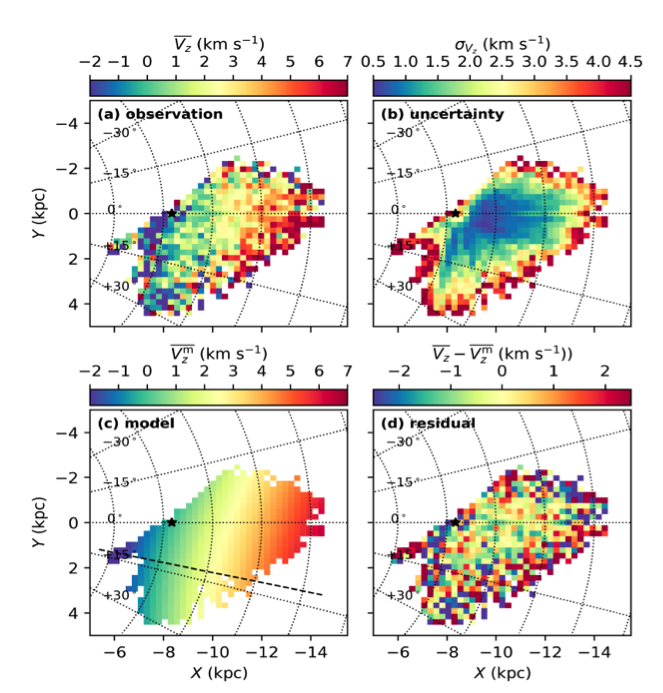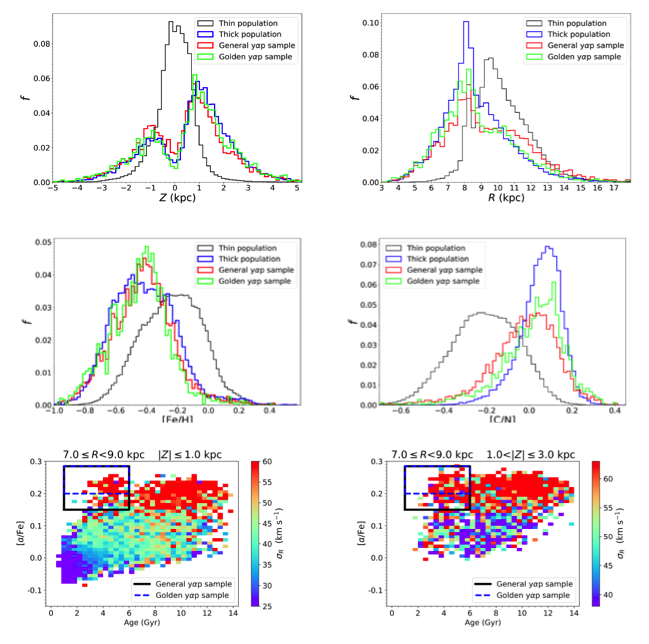新利18体育新研究团队发布LAMOST和Gaia的红团簇星样本并利用该样本取得系列重要进展
Mapping the Galactic Disk with the LAMOST and Gaia Red Clump Sample
近日,云南大学黄样副教授、刘晓为教授、牛津大学Ralph Schonrich博士、北京大学张华伟副教授等人基于LAMOST DR4光谱数据和Gaia DR2自行数据构建并发布了近14万颗主红团簇星的精确距离、质量、年龄和三维速度信息。这些数据对于许多重要前沿课题的研究具有重要的价值,目前已在银盘的速度场,外盘翘曲起源及星族起源等研究中发挥了作用,同时该样本将成为LAMOST巡天数据资源中非常重要的一部分,供国际同行使用。该成果发表在国际知名天文期刊《天体物理学报增刊》(Huang et al. 2020, ApJS, 249, 29)。
主红团簇星是中小质量恒星的氦主序阶段,它作为研究银河系(特别是银盘)的示踪体有如下优势:1)主红团簇星被认为是标准“烛光”,其距离精度高达5%-10%;2)主红团簇星的绝对星等比较亮,在LAMOST极限星等下可允许我们对银盘体积进行研究;(3)通过从LAMOST光谱中提取的恒星参数可以以较高的完备度和较低的污染率挑选出主红团簇星;(4)由于巨星经历过挖掘过程,可从光谱中的谱线特征得到主红团簇星的质量和年龄信息。基于以上优势,黄样等人从LAMOST DR4光谱数据中成功筛选出14万主红团簇巨星,利用Gaia DR2的三角视差信息对红团簇星进行绝对星等定标,得到了这些星的精确距离(5%-10%),并利用KPCA方法得到了这些星的质量(10%-15%)和年龄(20%-30%),结合Gaia DR2的自行信息进一步得到了14万主红团簇巨星的三维速度信息。该样本覆盖了银盘相当大的体积(如图1):4 kpc < R < 16 kpc, |Z| < 5 kpc, -20° < phi < 50°。
利用该样本,云南大学研究团队在理解银盘的速度场、外盘的翘曲以及特殊星族起源上取得了系列重要进展。具体如下:
一、银盘翘曲的运动学信号及视向节点角度的测量
旋涡星系的外盘普遍存在翘曲现象。作为一个典型的旋涡星系,上世纪60年代的射电观测揭示银河系外盘也存在显著的翘曲。随后通过对不同示踪物(如尘埃、恒星盘等)的观测进一步证实了银盘翘曲的存在。翘曲产生机制的理论有很多,如银河系卫星星系对银盘的扰动,内落气体的吸积等。要从观测上厘清银盘翘曲的成因不仅需要我们有对翘曲结构性质的了解,还需要我们从运动学上探测到翘曲信号加以限制。然而,银盘翘曲的运动学研究受限于银河系恒星自行精度的影响,在Gaia DR2释放之前的研究都是有限的。即使在Gaia DR2释放之后,受限于Gaia三角视差的精度,只能对外盘2-3 kpc内的翘曲信号进行探测。得益于本研究团队发布的红团簇星的精确距离测量,李新意等人首次对银盘外围远至4-5 kpc内的翘曲信号进行细致研究,并发现翘曲信号随方位角有显著变化,进而首次在运动学空间得到了银盘翘曲的视向节点角度(angle of line-of-node)为12.5度左右(图2),这与恒星计数法得到的结果高度一致。下一步,研究团队计划结合恒星计数和运动学来探究银盘翘曲的成因。
二、揭示特殊星族的起源
按照标准的银河系化学演化模型,早期诞生的盘星主要经历alpha元素增丰(大质量恒星死亡爆发的II型超新星的贡献),而金属丰度相对较低。后期,大质量恒星死亡殆尽,由小质量恒星死亡演化产物Ia型超新星主要贡献铁族元素增丰,而alpha元素相对变低。然而,最近基于星震学测量的年龄和大规模光谱巡天得到的alpha元素丰度,发现银盘上存在一族较为年轻(小于4-6 Gyr)的alpha元素增丰([alpha/Fe] > 0.15 dex)恒星,这些恒星显然不符合标准的银河系化学演化模型预言。目前关于这类特殊星族的起源有两种解释:一是这些星族的恒星成员起源于一类早期保存下来未受Ia型超新星增丰污染的原处气体环境;另一类是这些恒星很可能是双星吸积或并合演化的产物。区分这两种模型的关键是这些恒星是否真的年轻(前者模型下这些星是真的年轻,而后者实则是年老)。获知这些恒星的整体结构、化学以及运动学信息成为区分该族恒星是否年老的关键。由于样本数目的限制,前人的工作无法对这类星族的结构、化学和运动学性质进行统计性分析。黄样所在团队构建的主红团簇星大样本为研究这些工作提供了极佳的资源,孙伟祥等人从中筛选出了超过2000颗的该族恒星,通过对这些星的统计学研究发现,该类星族的结构、化学和运动学性质与传统的厚盘星性质几乎一致(图3),表明这些星并非真的年轻而实际上相当年老。基于此,研究团队最终揭示了该星族很可能起源于双星吸积或并合演化的产物。
此外,云南大学王海峰博士基于该样本已发表了3篇关于银盘速度场受扰动的文章。
截止目前,本研究团队基于该样本已被国际知名天文期刊《天体物理学报》(APJ)、《天体物理学报增刊》 (ApJS)及英国《皇家天文学会月刊》 (MNRAS)正式发表和接收文章6篇,这些成果的取得都表明了这个具有丰富信息的主红团簇星大样本在刻画银盘计划中的非凡价值和广阔的应用前景。
系列成果的论文链接如下:
https://ui.adsabs.harvard.edu/abs/2020ApJS..249...29H/abstract
https://ui.adsabs.harvard.edu/abs/2020MNRAS.491.2104W/abstract
https://ui.adsabs.harvard.edu/abs/2019ApJ...884..135W/abstract
https://ui.adsabs.harvard.edu/abs/2020arXiv200706947L/abstract
https://ui.adsabs.harvard.edu/abs/2020ApJ...897..119W/abstract
https://ui.adsabs.harvard.edu/abs/2020arXiv200810218S/abstract

图1: 基于LAMOST和Gaia的红团簇星样本的空间分布。Fig. 1: Number density distribution of our primary RC sample stars in the X–Y (the left panel) and X–Z (the right panel) planes.

图2:利用LAMOST和Gaia的红团簇星样本绘制的银盘平均垂向速度在盘平面上的分布及利用简单翘曲模型对平均垂向速度的拟合。Fig. 2: Distributions of mean vertical velocities in the X-Y plane.

图3:“年轻”[alpha/Fe]增丰星族的结构(上图)、化学(中图)及运动学(下图)与传统化学薄厚盘的比较。Fig. 3: The spatial distributions (the top panel), chemical distributions (the middle panel) and kinematic properties (the bottom panel) of the “young” [alpha/Fe] enhanced, chemically thin and thick disk populations.

Primary red clump (RC) stars are metal-rich low-mass stars of intermediate to old age in the core helium-burning phase (ignited degenerately). They are widely used as distance indicators given their quite stable luminosities that are weakly dependent on chemical composition and age. As standard candles widely distributed across the entire Galactic disk, RCs are excellent tracers to explore the three-dimensional structure, study the chemical and kinematic properties, and unravel the assemblage history of the Galactic disk.
Based on stellar atmospheric parameters deduced with the latest version of LSP3 for whole LAMOST DR4, nearly 140,000 primary RC stars of spectral S/Ns higher than 20 have been successfully singled out. The stellar masses and ages of those stars are further determined from the LAMOST spectra, using the kernel principal component analysis (KPCA) method and are trained with thousands of RCs in the LAMOST–Kepler fields with accurate asteroseismic mass measurements. Various tests show typical uncertainties of 15% and 30%, respectively, for the estimated masses and ages. Using over 10,000 primary RCs with accurate distance measurements from the Gaia DR2 parallaxes, the Ks–band absolute magnitudes of the primary RC are recalibrated by considering the effects of both metallicity and age, for the first time. With this new calibration, very accurate distances are derived for the whole sample, with typical uncertainties of 5%–10%, which are even better than the Gaia measurements for stars beyond 3–4 kpc.
The sample covers a significant volume of the Galactic disk of 4 kpc < R < 16 kpc, |Z| < 5 kpc, -20 < phi < 50°. Stellar parameters, line-of-sight velocities, and elemental abundances deduced from the LAMOST spectra and proper motions from the Gaia DR2 are also provided in the whole sample stars. The sample is of vital importance to probe the structural, chemical, and kinematic properties of the Galactic disk(s) and is available at https://zenodo.org/deposit/3875974. The paper has been published in The Astrophysical Journal Supplement Series (Huang et al. 2020, ApJS, 249, 29).
Based on the above RC sample, the YUN team has made progresses on the velocity field of the Galactic disk, the disk warp and the origin of the “young” [alpha/Fe] enhanced population:
1. The kinematic signature of the Galactic warp
Disk warping in the outer regions of spiral galaxies (>50%) is a very common phenomenon. Being a typical spiral galaxy, the Milky Way also shows clear warp in the outer disk. The Galactic warp was first detected by Kerr (1957) with H I 21-cm line observation. Not only the neutral gas, other components of the Galactic disk also show that the Galactic outer disk is strongly warped, including the stars, the molecular clouds and the interstellar dust grains. Theoretically, warping of a spiral galaxy is generally interpreted as the response of the disk to perturbations. While many scenarios have been proposed, the exact origin of the Galactic warp remains unclear. Further information of the kinematic signature of the Galactic warp would be invaluable to clarify the situation. Prior to the Gaia data release, several studies attempted to unravel the kinematic signature of the Galactic warp, but their results are inconclusive due to the limited accuracy of proper motions employed. With Gaia data release, the kinematic signal of the Galactic disk has been clearly detected, while more detail 2D map is still limited to the distance derived from the Gaia parallax. By using RC sample with accurate 3D position and 3D velocity measurements, the YNU team has explored the kinematic warp signature of the Galactic disk(s) in the Galactic plane. For the thin disk population, a clear positive gradient of mean vertical velocity as a function of R. The warp signature for the thick disk population is much weaker, largely due to the hot nature of orbits of thick disk stars. For the thin disk stars, we further explore the variations of mean vertical velocity (as a function of R) for the different azimuthal slices and find the amplitude of warp increases with azimuthal angle and reaches a maximum in slice between 10 and 17 deg. To quantitively determine the angle of line-of-node of the warp, we fit the distribution of mean vertical velocities of the thin disk stars with a long-lived static warp model and find an angle around 12.5◦, in excellent agreement with the previous estimates from star counting.
2. On the origin of the “young” alpha enhanced stars
The classical Galactic chemical evolution (GCE) models predict strong correlations amongst stellar metallicity [Fe/H], [alpha/Fe] abundance ratio and age for disk stars, as a result of the different histories of element enrichment and star formation rate. Generally, thick disk stars were born at the early stage (thus very old) and experienced elements enrichment as a product of the core collapse supernovae (SNe) of massive stars. The thin disk stars are typically much younger with iron-peak elements enriched mainly by Type Ia SNe (thus with high [Fe/H] and depressed [alpha/Fe]). However, this paradigm has recently been challenged by analyses of sample stars beyond the solar neighbourhood (> 100 pc) that have robust age determinations, owing to the precise asteroseismic measurements from the CoRoT and Kepler satellites. By combining the asteroseismic ages and [alpha/Fe] abundance ratios given by the APOGEE medium-to-high resolution spectroscopic surveys, Chiappini et al. (2015) and Martig et al. (2015) first found a handful stars with enhanced [alpha/Fe] abundance ratios ([alpha/Fe]> 0.1 dex) but of young ages (< 6.0 Gyr). The existence of this intriguing group of stars has been confirmed by the follow-up work. Those “young” [alpha/Fe]-enhanced stars are certainly unexpected from the classical GCE models. The origin of those “young” [alpha/Fe]-enhanced stars is still an open question. Hitherto, two possible explanations have been proposed. The first one is that those stars are evolved blue stragglers and their true ages have been underestimated because of the large current masses that result from the merger or mass transfer. The second scenario is that those stars are newly formed in a recent pristine gas (not polluted by SNe Ia ejecta) accretion episode at some particular positions of the Galaxy. The key to distinguishing the two scenarios is finding alternative independent age indicators to check that those “young” [alpha/Fe]-enhanced stars are on earth young or old.
By using the RC sample, The YNU team has identified a large sample of “young” [alpha/Fe]-enhanced stars of ages younger than 6.0 Gyr and [alpha/Fe] values greater than 0.15 dex. To explore their possible origins, the team has analyzed their spatial distribution, and the chemical and kinematic properties and compared the results with those of the chemically thin and thick disk populations. The team finds that the aforementioned properties of the “young” [alpha/Fe]-enhanced sample stars are almost the same as those of the chemically thick disk population. The results support the idea that these stars are not really young but genuinely old, and therefore prefer stellar merger or mass transfer as their most likely origin.
So far, six papers based on the RC sample have been accepted by the professional astronomical journals: The Astrophysical Journal (ApJ), The Astrophysical Journal Supplement (ApJS) and Monthly Notices of the Royal Astronomical Society (MNRAS).
The links to those papers are:
https://ui.adsabs.harvard.edu/abs/2020ApJS..249...29H/abstract
https://ui.adsabs.harvard.edu/abs/2020MNRAS.491.2104W/abstract
https://ui.adsabs.harvard.edu/abs/2019ApJ...884..135W/abstract
https://ui.adsabs.harvard.edu/abs/2020arXiv200706947L/abstract
https://ui.adsabs.harvard.edu/abs/2020ApJ...897..119W/abstract
https://ui.adsabs.harvard.edu/abs/2020arXiv200810218S/abstract
